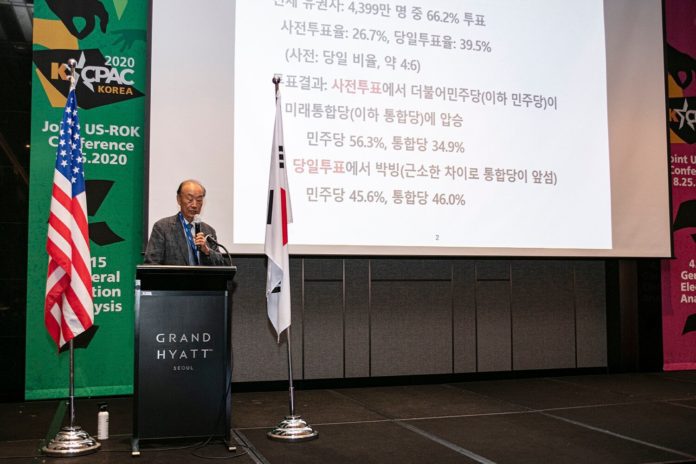KCPAC 2020 ROK-USA Conference
4.15 General Election Analysis
Grand Hyatt Hotel, Seoul, South Korea
1. A huge divergence between the results of early-voting and voting on election day.
According to the National Election Commission, over 11.74 million of the total 43.90 million voters pre-voted in the past general elections on April 15th, an extremely high pre-vote rate of 26.7%. Since the on-site voting rate was 39.5%, the voting rate of this election is very high at its 66.2%, making the ratio of the number of pre-votes and the number of on-site votes about 40:60. Looking at the voting rates of the Democratic Party of Korea (hereinafter the Democratic Party) and the United Future Party (hereinafter the UFP), there is a big difference between the results of early-voting and the on-site voting in all 253 constituencies. In the pre-vote, the Democratic Party gained 56.3% and the UFP 34.9%, the Democratic Party winning by a landslide. During the on-site voting, the Democratic Party gained 45.6% and the UFP 46.0%, the UFP winning by a thread. However, as the Democratic Party created a wide gap during the pre-voting, constituency elections ended with a record victory for the Democratic Party.
But what is statistically unusual is that in 253 national constituencies, the Democratic Party received an average of 10.7% less votes than the pre-votes during the on-site voting, and the UFP received an average of 11.1% more votes during the on-site voting than during the pre-voting. <Figure 1> shows the histograms of the difference in votes the two parties gained during the pre-voting and the on-site voting. The fact that the two-party histograms do not overlap at all is evidence that the same pattern occurs in all districts.
On the other hand, the 20th general elections in 2016 shows the histogram shown in <Figure 2>. Becasue there are overlapping histograms, the Democratic Party could have gotten a better turnout during the on-site vote than the pre-vote, and the UFP (Saenuri Party at the time) also could have gotten a better turnout on the pre-votes than the on-site votes according to the constituencies. It is fully possible because averages between the two parties are not too great, as the average of the Democratic Party’s histogram is about -2%, and the average of the UFP about 3%.

<Figure 1> Histogram of 21st General Elections in 2016 showing the difference of voting rates according to constituencies.
Vertical axis (x-axis): (rate of on-site voting – rate of pre-voting)
Horizontal axis (y-axis)): Frequency of constituencies within the section

<Figure 2> Histogram of the 2016 20th General Elections showing the difference in the percentage of votes by constituencies
So why did this happen in the 21st elections? In general, it is possible to think that many young people participated in the pre-voting and leaned towards the Democratic Party. However, the age distribution of the voters who participated in the pre-voting (April 10-11) is shown in <Figure 3>. Looking at the ratio of voters by age, those in their 60s and above accounted for highest percentage of 30.8%, followed by 21.9% in their 50s, and 52.7% in their 50s and above combined. In fact, seniors 50 years old or older participated in the pre-voting more than young people in their 20s and 30s. According to the polls, this does not explain why the Democratic Party’s support is high in the pre-voting because the elderly has high support for the UFP. Statistically speaking, the entirety of nationwide voters is one population; even when this population is considered to have voted in two randomly divided groups (pre-voter group and on-site voter group), it is difficult for these groups to have a great difference between them. The huge gap between pre-voting and on-site voting is statistically difficult to understand.

263,505/ 1,720,000 / 1,494,267 / 207,004,663/ 257,006,527 / 361,003,713
<Figure 3> Number of voters by age in the 21st General Elections
2. Is the statistical hypothesis that Democratic supporters have flocked to early voting true?
In local pre-elections, the Democratic Party won by a landslide with 56.3% against the UFP’s 34.9%, whereas on the day of the vote, the UFP won by narrow margin over the Democratic Party, 46.0% to 45.6%. In order to explain a phenomenon such as this, the hypothesis that Democratic supporters flocked to the pre-elections more than UFP supporters must be formed. Let us statistically verify this hypothesis. In <Figure 4>, the x-axis depicts the total percentage of Democratic votes (pre- and on-site votes) and in the 1,537 neighborhoods, towns, townships, and villages in Seoul, Gyeonggi, Incheon, Gangwon, Daejeon, and Busan (hereinafter referred to as neighborhoods), whereas the y-axis depicts the percentages of pre-votes (total number of pre-votes/total number of votes) by neighborhood. If the hypothesis that many Democratic supports came out to vote for the pre-elections is true, then the higher the total percentage of Democratic votes in the x-axis, the higher the percentage of Democratic pre-votes should be. In other words, the graph should show a positive correlation as well as a positive slope (+). However, we can see that this is not the case in <Figure 4>. Conclusively speaking, the hypothesis that Democratic supporters flocked to the pre-elections by the mass is not statistically proven to be true

(1,537 neighborhoods, towns, townships, villages in Seoul, Gyeonggi, Incheon, Daejeon, and Busan)
Y-Axis: Pre-Election Percentages by Neighborhood (Pre-Election Votes/Total Votes)
X-Axis: Percentages of Total Democratic Votes (Pre- and On-Site)
<Figure 4> Democratic Total Amount of Votes: Scatter Plot of Pre-Election Votes by Neighborhood
(Source: Provided by Professor Jung Hoon from Waseda University’s Department of Economics and Political Science)
3. Highly similar patterns found in 49 constituencies and 424 neighborhoods of Seoul statistically difficult to understand.
As all 49 constituencies of Seoul each have their own candidates they prefer to support, it is common for the rates of candidate support to variously differ. However, the fact that the percentages of pre-votes and on-site votes are nearly the same in all constituencies is a phenomenon so strange that it is statistically hard to believe. The Democratic candidate received a greater percentage of votes in the pre-elections rather than on-site, and the UFP experienced the very opposite. But in the last 2016 general elections, the average difference between pre-election and on-site percentages was but approximately -3% for the Democratic Party and +3% for the then-Saenuri Party, therefore leading to an overall gap of roughly 6% between the two parties. This is a gap that, statistically speaking, is fully possible. However, this 21st General Elections saw only large negative differences in the Democratic Party (10%~-16%), recording an average of 12%. On the other hand, the UFP recorded only big positive differences that amounted to an average of about 12%. The resulting average differences of both parties then becomes the enormous value of 24%. What can especially be a statistically strange phenomenon is that the same pattern was found in all 49 constituencies.
Seoul is comprised of 424 total neighborhoods; the differences between the Democratic pre-votes and on-site votes were plotted as a histogram shown in <Figure 5>. The differences show an average of 12% and has a small standard deviation of 2.4%. It is a statistically odd phenomenon that Democratic pre-vote percentages are higher than on-site percentages in all 424 neighborhoods, coupled with an unusually small standard deviation. Even though each of the 424 neighborhoods should have their own characteristics, to have such a uniform result as this is difficult to understand statistically.

<Figure 5> Democratic Votes of Seoul’s 424 Neighborhoods (Pre- and on-site voting percentages histogram)
(Source: Central Election Management Committee, vertically the number of neighborhoods, horizontally the percentages)



